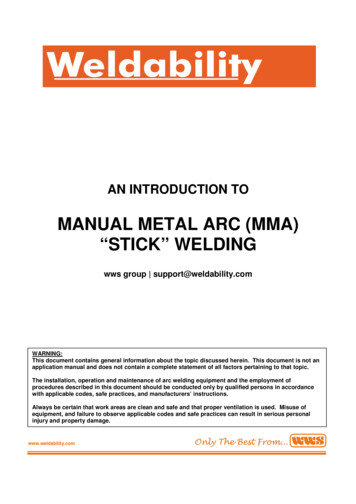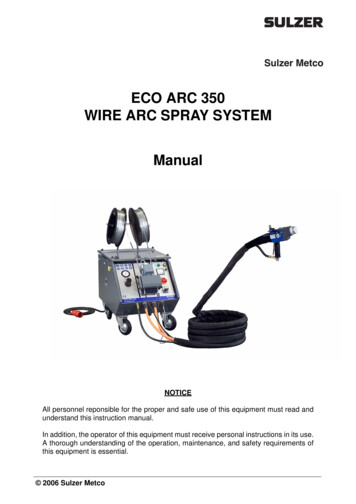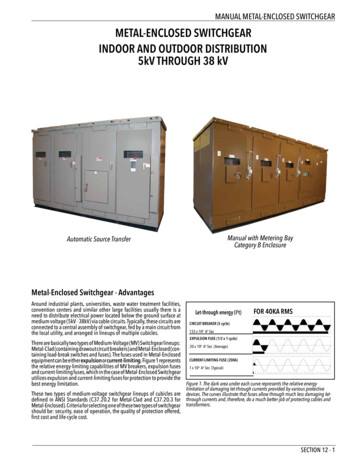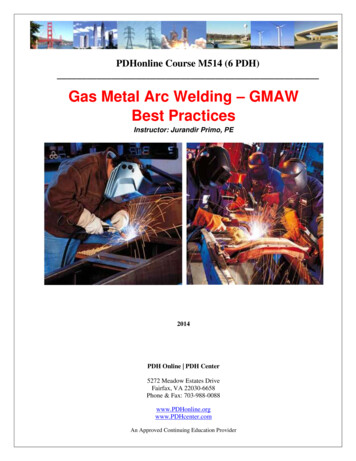
Transcription
AN INTRODUCTION TOMANUAL METAL ARC (MMA)“STICK” WELDINGwws group support@weldability.comWARNING:This document contains general information about the topic discussed herein. This document is not anapplication manual and does not contain a complete statement of all factors pertaining to that topic.The installation, operation and maintenance of arc welding equipment and the employment ofprocedures described in this document should be conducted only by qualified persons in accordancewith applicable codes, safe practices, and manufacturers’ instructions.Always be certain that work areas are clean and safe and that proper ventilation is used. Misuse ofequipment, and failure to observe applicable codes and safe practices can result in serious personalinjury and property damage.www.weldability.com
an introduction to MMA “Stick” weldingIntroductionArc welding with coated electrodes is a manual process where the heat source consists of the electric arc.When the arc strikes between the coated electrode (by means of an electrode holder) and the piece to bewelded (base material), it generates heat which causes rapid melting of both the base material and electrode.The welding circuit consists essentially of the following elements: a power source an electrode holder coated electrodes an earth clamp and earth cablesas illustrated in figure 2 below.figure 1The Power SourceThe purpose of the power source is to feed the electric arc, which ispresent between the base material and the electrode, through theoutput of a current sufficient in quantity to keep the arc struck.figure 2Electrode welding is based on the constant current principle i.e. thecurrent delivered by the power source should not vary when theoperator moves the electrode towards the piece. The mainconstruction property of the source is therefore to keep the currentunchanged in the presence of variations in arc length as theelectrode moves closer to or away from the piece: the more constantthe current, the more stable results the arc and the simpler theoperator's work.Inside the power source, there is usually a welding current adjustment device, of a mechanical (e.g a magneticshunt) or electronic type (SCR systems or inverter systems). This distinction can be used to classify electrodewelding machines into three families, depending on their construction technology: electromechanical weldingmachines, electronic welding machines (SCR), inverter welding machines. The polarity of the power sourceoutput current distinguishes two further categories:a) direct current (DC) power source(see figure 3)The power source output current has a continuous wave form, which is obtainedby means of a device, the rectifier, which is situated at the base of thetransformer and can convert from alternating to direct current. This output istypical of electronic SCR and inverter power sources.If the welding circuit has a direct current (DC) power source, it can be furtherclassified according to the method of connecting the power source poles to thematerial to be welded:b) alternating current (AC) power source (see figure 4)The power source output current takes the form of a sine wave, which changes itspolarity at regular intervals, with a frequency of 50 or 60 cycles per second(Hertz). It is obtained using a transformer, which converts the mains current into asuitable current for welding. This is for electromechanical welding machines.figure 3figure 4i) straight polarity connectionStraight polarity connection occurs when the clamp cable (with the electrode holder clamp) is connected to thenegative pole (-) of the power source and the earth cable (with the earth clamp) to the positive pole ( ) of thepower source. The electric arc concentrates the heat produced on the piece and causes its melting. In this way,as the core of the electrode melts, it is deposited and penetrates into the welding joint.page 2 of 11www.weldability.com support@weldability.com
an introduction to MMA “Stick” weldingii) reverse polarity connectionReverse polarity connection occurs when the clamp cable (with the electrode holder clamp) is connected to thepositive pole ( ) of the power source and the earth cable (with the earth clamp) to the negative pole (-) of thepower source. The heat of the electric arc is mostly concentrated at the tip of the electrode. Each type ofelectrode requires a specific current type (AC or DC) and, in the case of DC current, a specific polarity: thechoice of the electrode therefore depends on the type of power source used. Incorrect use will cause arc stabilityproblems and hence also welding quality problems.electrode holderfigure 5The primary function of the electrode holder is to support the electrode, guaranteeinga good electrical contact for current passage; it should also guarantee sufficientelectrical insulation for the welding operator.earth clamp and cablesfigure 6The earth clamp is a tool that, via the earth cable, ensures the electrical circuit isclosed between the welding power source and the piece to be welded. The clampand earth cables, connected to the electrode holder and earth clamp respectively,permit an electrical connection between the power source and the base material tobe welded. The choice of cable section and length should be based on the maximumwelding current in amps.coated electrodesThe coated electrode consists of a core and a coating. The core consists of a metalconductor rod whose sole purpose is to supply welding material to the piece. Thematerial used depends on the base material: for carbon steels, for which electrodewelding is most widespread, the core is in mild steel. During welding the core meltsslightly before the coating does.figure 7The coating is the most important part of the electrode and has many functions. Itprimarily serves to protect the weld from contamination, and it achieves this in two ways: i) By volatilizing, andthen modifying the atmosphere surrounding the weld pool by delay melting, the core is consequently protectedby the naturally formed crater; ii) by liquefying and floating on top of the pool, the bead is protected as it cools.It also contains material capable of purifying the base material and elements that could contribute to the creationof alloys in the melt. The choice of coating is therefore very important and depends on the characteristics to begiven to the weld. The coating can also contain weld material as a powder, to increase the quantity of depositedmaterial and hence the welding rate. In this case we refer to high performance electrodes.modern power source featuresModern inverter welding power sources may contain special features whose functions are to facilitate easierwelding. These devices can include ‘arc force’, ‘hot start’ and ‘anti-stick’ technology.An ‘arc force’ device eases the transfer of drops of melted material from the electrode to the base material,preventing the arc from extinguishing when the drops cause contact (i.e. a short circuit) between the electrodeand the weld pool.A ‘hot start’ device facilitates the striking of the electric arc, by supplying an ‘over-current’ every time weldingrestarts.An ‘anti-stick’ device automatically switches off the power source if the electrode sticks to the base material, thusallowing it to be removed manually without ruining the electrode holder clamp.page 3 of 11www.weldability.com support@weldability.com
an introduction to MMA “Stick” weldingGeneral PrinciplesShielded metal-arc welding with the transformer welding machine depends upon the fundamental fact that whenone side of the welding circuit is attached to a piece of steel, a welding electrode connected to the other side andthe two brought into contact, an arc will be established. If the arc is properly controlled, the metal from theelectrode will pass through the arc and be deposited on the steel. When the electrode is moved along the steelat the correct speed, the metal will deposit in a uniform layer called a bead. The electrodes used in welding arecarefully manufactured to produce strong, sound welds. They consist of a core of steel wire, usually called mildsince it contains a low (0.10-0.14) percentage of carbon. Around this core is applied a special coating whichassists in creating the arc and at the same time protects the molten steel as it transfers across the arc.In order to utilize these principals in metal-arc welding, some means of controlling the power is essential. Thepower in a circuit is measured by the voltage and current. However, the voltage is governed by the arc lengthand in turn depends on the electrode diameter. Therefore, the practical measure of the power, or heat, is interms of the current, generally measured in amperes. Obviously a small electrode requires less current than alarge one. To simplify operations the scale on the front of the welding machine is marked off for the variouscurrent values.The exact current selected for a job dependsupon the size of the pieces to be welded and theposition of welding. Generally a lower current willbe sufficient for welding on a small part thanwould be necessary to weld on a large piece ofthe same thickness. Similarly, with a given size ofelectrode a lower current should be used on thinmetals than on the heavier sections.While it is always a good policy to weld on work inthe flat position, as shown in figure 8,occasionally, when working on machines or otherlarge units it will be necessary to weld in avertical, horizontal or overhead position as shownin figures 9, 10 and 11 respectively. Generally,under these difficult conditions it is helpful toreduce the current from the value used on weldingin the flat position.figure 10figure 8figure 9In learning to weldthere are certainfundamental steps,which must bemastered beforeone can attempt toweld on actualwork. Preparatoryto the actual strikingof an arc, it isnecessary to insertthe electrode in theholder, as shown infigure 12.figure 12figure 11Arc IgnitionFor striking an arc, figure 13 illustrates what is commonly known as the “scratching technique”. In this methodthe striking end of the electrode is dragged across the work in a manner much the same as striking a match.When the electrode touches the work, the welding current starts. If held in this position, the electrode wouldpage 4 of 11www.weldability.com support@weldability.com
an introduction to MMA “Stick” welding“freeze” or weld itself to the work and to overcome this,the electrode is withdrawn from the work immediatelyafter contact has been made.The amount that the electrode is withdrawn is small anddepends upon the diameter: this distance is known asthe arc length. If in striking an arc, the electrode freezes,it may be freed by a quick twist of the wrist.figure 13Another method of establishing the arc is available. It isknown at the “tapping method” (see figure 14) where theelectrode holder is brought straight down on the workand withdrawn straight after contact to the proper length.Practice striking the arc using both methods. Generallythe scratching method is preferred for a-c welding.Determination of the correct arc length is difficult sincethere is no ready means for measuring it. As apreliminary guide, use about 1.6mm arc length on1.6mm and 2.4mm electrode; for 3.2mm and 4.0mmelectrodes use about 3.2mm arc length. When skill isacquired, the sound of the arc will be a good guide. Ashort arc with correct current will give a sharp, cracklingsound. Examination of the deposited bead will give afurther check.Once the knack of starting and holding an arc has beenlearned, turn next to depositing weld metal. In thebeginning it is best to run beads of weld metal on flatfigure 14plates using a full electrode. Practice moving from left toright and from right to left. The electrode should be held more or less perpendicular to the work, except thattilting it ahead, in the direction of travel will prove helpful. The correct position is shown in figure 15. A properbead is shown in figure 16 while figure 17 illustrates a cross section through the bead and identifies the variousterms used in describing a weld. To produce these results it is necessary to hold a short arc, travel at a uniformspeed, and feed the electrode downward at a constant rate as it melts.figure 15figure 16figure 17www.weldability.com support@weldability.compage 5 of 11
an introduction to MMA “Stick” weldingfigure 18figure 19Probably the first attempts in the practice will fall short ofthe results shown. Too long an arc will be held or the travel speed will vary from slow to fast and the welds willlook like the one in figure 18. A cross-section through such a weld is given in figure 19. In addition the weld willprobably be spongy (porous) and of low strength.Continue practicing until uniform beads asshown in figure 18 can be produced everytime. A good method of practicing is to deposita series of beads, one next to the other untilthe plate is covered. Then deposit anotherseries of beads at right angles to the first, thusbuilding up the plate to a greater thickness.WeavingWhen it is necessary to cover a wider area inone pass of the electrode, a method known asweaving is employed. In this the electrode ismoved or oscillated from side to side in a setpattern. In order to be sure of uniformdeposits, it is necessary to use a definitepattern such as those illustrated in figure 20.While weaving is helpful, particularly whenbuilding up metal, it should be limited toweaves not exceeding 2.5 times the diameterof the electrode.Butt JointsUp to this point the discussion has coveredonly the deposit of beads on the flat plates.figure 20While such operations are helpful in buildingup worn parts or applying hard-facing materials, they do not help in learning to weld pieces together. For thispurpose, other types of welds are illustrated in figure 21 are necessary.In making bead welds, previously described, it was probably noted thatthe depositing of weld metal on one side of the plate caused
Arc welding with coated electrodes is a manual process where the heat source consists of the electric arc. When the arc strikes between the coated electrode (by means











